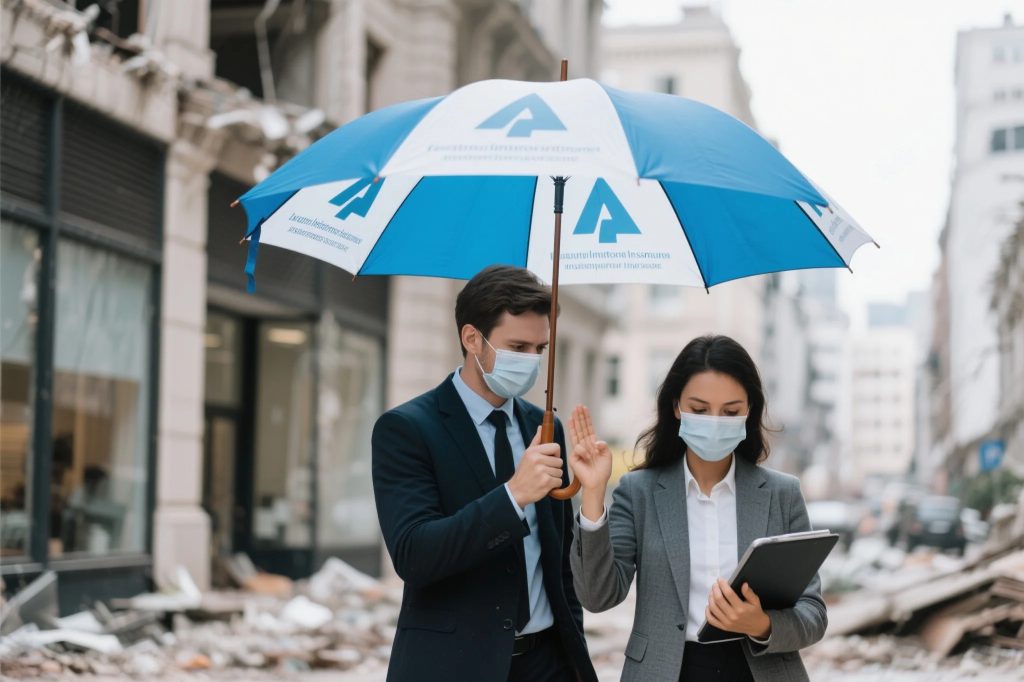The Lifeline Your Business Can’t Afford to Ignore
When disaster strikes, business interruption insurance often becomes the difference between reopening your doors and closing them forever. This critical coverage protects your income stream when covered perils force temporary shutdowns, yet nearly 40% of small businesses operate without it. What most owners don’t realize is that standard property policies only cover physical damage – they won’t replace the revenue you lose during reconstruction or recovery periods. The modern risk landscape includes threats ranging from cyberattacks that freeze operations to supply chain failures that halt production, none of which involve property damage but all of which can devastate cash flow. A well-structured business interruption policy acts as a financial airbag, cushioning the blow from lost income, ongoing expenses like payroll and loans, and even the extra costs of operating from temporary locations. As we’ve seen from recent global events, recovery periods often stretch far longer than optimistic projections, making adequate coverage limits and duration essential for survival.
How Business Income Protection Works in Real Crises
business income protection functions differently than most business owners expect when they first purchase coverage. Unlike property insurance that pays for physical repairs, this coverage reimburses you for the profits you would have earned had the disaster not occurred. The most comprehensive policies cover not just fixed costs but also net profits, based on your financial records from prior periods. Many include extended indemnity provisions that continue payments for a set period after you reopen, recognizing that revenue doesn’t immediately return to pre-disaster levels. Perhaps most importantly, these policies typically cover losses stemming from damage at supplier or customer locations that disrupt your operations – a critical protection in today’s interconnected economy. The claims process requires detailed financial documentation, making organized record-keeping before a crisis essential for maximizing your recovery. Businesses that understand these nuances can structure their coverage to match their specific revenue patterns and financial obligations.
Common Gaps in Business Interruption Coverage
Even businesses with business interruption insurance often discover dangerous gaps when they need to file claims. Many policies contain waiting periods before coverage activates, typically 48-72 hours, leaving short disruptions uncovered. Some exclude certain perils like pandemics, utility failures, or civil authority closures that don’t involve physical damage to your property. Others limit coverage to specific locations, failing to protect against supply chain or distribution network failures. The most problematic gap comes from underinsurance – policies based on outdated revenue projections won’t cover current income levels, and those with insufficient duration may expire before you fully recover. Many businesses also overlook the need for contingent business interruption coverage that protects against losses stemming from damage at key supplier or customer locations. Regular policy reviews with insurance professionals help identify these vulnerabilities before disasters strike, allowing for strategic endorsements that create comprehensive protection.
Integrating Business Interruption With Other Coverages
Effective business income protection requires coordination with your broader insurance portfolio. Your general liability insurance for business won’t respond to income losses, but it may cover third-party claims arising from the same incident that triggered your shutdown. business hazard insurance protects physical assets, while business interruption covers the financial consequences of being unable to use those assets. Many businesses benefit from adding extra expense coverage that reimburses costs incurred to minimize shutdowns, like temporary relocation or overtime wages. For larger operations, umbrella insurance for companies can provide additional liability protection during vulnerable recovery periods when accidents are more likely. The most comprehensive programs layer these coverages to eliminate gaps where neither policy responds, creating a seamless safety net that addresses all aspects of crisis recovery from physical repairs to financial stabilization.
Calculating Adequate Coverage Limits and Periods
Determining proper limits for your business interruption insurance requires more than just glancing at last year’s profit and loss statement. Start by analyzing your financials to identify fixed costs that continue during closures – rent, loan payments, salaries for key personnel, and other non-negotiable expenses. Then project variable costs you could reduce if operations halt, like temporary labor or raw material purchases. Most critically, estimate your likely net income loss based on historical revenue patterns, seasonal fluctuations, and growth trends. The coverage period presents another complex calculation – while 12 months was once standard, many businesses now opt for 18-24 months after seeing how prolonged recent recoveries have become. Businesses with long lead times to restore operations, like manufacturers needing to replace specialized equipment, should consider even longer restoration periods. Working with accountants and insurance professionals ensures your projections withstand insurer scrutiny while protecting your full financial exposure.

Special Considerations for Different Industries
The ideal business income protection strategy varies dramatically across industries, demanding tailored solutions rather than one-size-fits-all policies. Manufacturers need coverage that accounts for both finished goods inventory losses and the extended time required to restart complex production lines. Retailers should ensure policies cover peak season revenues, not just annual averages, and include contingent business interruption for distribution center failures. Restaurants require spoilage coverage for perishable inventory and may need endorsements for delivery revenue losses. Professional service firms often benefit from adding extra expense coverage for remote work setups during office closures. Construction companies need policies that recognize how project delays create cascading liabilities beyond simple income loss. The most effective programs work with brokers who specialize in specific industries, ensuring policy language matches actual operational risks rather than relying on generic forms containing inappropriate limitations.
Navigating the Claims Process Successfully
Filing a business interruption insurance claim presents unique challenges that differ substantially from property damage claims. Insurers will scrutinize your pre-loss financial records to establish a baseline for normal operations, making organized bookkeeping essential. They’ll compare your actual post-loss performance against projected performance had the incident not occurred – a complex calculation requiring detailed documentation. Many policies require you to mitigate losses by resuming operations as quickly as possible, though what constitutes “reasonable” efforts often becomes disputed. The claims process typically moves slower than property claims, as insurers verify extensive financial data before issuing payments. Businesses that maintain meticulous records, document all loss mitigation efforts, and work with experienced public adjusters or attorneys often achieve better outcomes. Perhaps most importantly, understanding your policy’s specific requirements before a loss occurs positions you to document everything insurers will need from day one of the disruption.
Emerging Risks and Evolving Coverage Needs
The business income protection landscape continues evolving to address novel threats that traditional policies weren’t designed to handle. Cyber incidents now represent a leading cause of business interruptions, yet many standard policies exclude digital perils unless specifically endorsed. Climate change has increased weather-related disruptions, with some insurers introducing parametric triggers that pay based on measurable events rather than physical damage. The COVID-19 pandemic exposed gaps in coverage for communicable disease closures, leading to new endorsement options. Supply chain vulnerabilities have prompted more businesses to seek contingent business interruption coverage for supplier network failures. Forward-thinking companies conduct annual coverage reviews that account for these emerging risks rather than relying on outdated policies that could prove inadequate when new types of disasters strike. The most comprehensive protection now includes a mix of traditional and innovative solutions tailored to your specific vulnerabilities.
Cost Control Strategies for Business Interruption Coverage
While comprehensive business interruption insurance represents a significant expense, several strategies can optimize costs without creating dangerous coverage gaps. Higher waiting periods before coverage activates (e.g., 7 days instead of 3) can substantially reduce premiums for businesses that could withstand brief disruptions. Implementing robust business continuity plans demonstrates risk mitigation to insurers, potentially qualifying for premium credits. Bundling business interruption with business hazard insurance often yields package discounts unavailable when purchasing separately. For businesses with multiple locations, blanket coverage that aggregates values across properties sometimes offers better rates than individual policies. Perhaps most importantly, accurate (not inflated) revenue projections prevent overpaying for unnecessary coverage while ensuring adequate protection. Regular policy reviews with insurance professionals help identify these cost-saving opportunities while maintaining essential protections.
Common Myths That Leave Businesses Exposed
Several dangerous misconceptions persist about business income protection that leave companies vulnerable when disasters strike. Many owners believe their general liability insurance for business covers income losses, when in reality it only addresses third-party claims. Others assume business interruption automatically activates during any closure, not realizing it requires physical damage from a covered peril. Some think their savings or lines of credit can bridge recovery gaps, underestimating how long disruptions often last. Perhaps most dangerously, businesses often believe they can quickly secure coverage after seeing storm forecasts or other warnings, not realizing insurers impose waiting periods for new policies. The truth is that proper business interruption planning requires advance preparation – documenting operations, understanding policy terms, and structuring coverage before threats materialize. Businesses that dispel these myths position themselves to survive disruptions that shutter unprepared competitors.
Building a Comprehensive Business Continuity Plan
While business interruption insurance provides financial protection, the most resilient companies combine coverage with proactive continuity planning. Start by identifying critical operations, key personnel, and essential equipment without which your business cannot function. Document supplier relationships and alternative sourcing options to minimize single points of failure. Create communication trees for reaching employees, customers, and vendors during disruptions. Implement data backup and remote work capabilities that allow partial operations to continue. Perhaps most importantly, conduct regular drills that simulate various disaster scenarios, revealing unanticipated vulnerabilities. These preparations not only minimize actual income losses but also demonstrate to insurers that you’re a better risk, potentially qualifying for premium reductions. The most effective plans integrate insurance with operational safeguards, creating multiple layers of protection that address both immediate crisis response and long-term recovery.
How Umbrella Insurance Complements Business Interruption
Savvy businesses pair their business income protection with umbrella insurance for companies to create comprehensive crisis resilience. While business interruption covers lost income, umbrella policies provide additional liability protection during vulnerable recovery periods when accidents are more likely. These policies kick in when primary liability limits exhaust, offering millions in additional coverage at relatively modest costs. For businesses operating in multiple states, umbrella coverage can help standardize protection across jurisdictions with varying liability laws. Perhaps most importantly, umbrella policies often fill coverage gaps in primary insurance, responding to claims like false arrest or libel that standard liability insurance might exclude. As lawsuit awards continue rising across all industries, having adequate liability protection during business interruptions has become essential for preventing a manageable crisis from becoming a catastrophic one.
Selecting the Right Insurance Provider
Choosing a carrier for your business interruption insurance requires more consideration than just comparing premium quotes. Insurer financial strength ratings indicate the ability to pay claims, particularly important for business interruption where payments may continue for months or years. Claims service reputation determines how smoothly the recovery process will go when you’re most vulnerable. Look for carriers with experience in your industry who understand your specific revenue patterns and recovery challenges. Evaluate the risk control resources insurers provide, like business continuity planning tools or disaster preparedness guides. Perhaps most critically, you want an insurer that pays claims fairly and promptly rather than one known for aggressive denials or delays. Working with brokers who have longstanding relationships with multiple carriers helps identify insurers with both competitive pricing and reliable claims service when disasters strike.
Annual Review Checklist for Optimal Protection
Treating your business income protection as a static purchase rather than an evolving strategy represents one of the most common – and costly – mistakes businesses make. Conduct annual reviews that account for revenue growth, new locations, expanded product lines, or changes in supplier networks. Update coverage limits to reflect current financial statements rather than outdated projections. Review policy exclusions to identify new risks needing endorsements, like cyber incidents or supply chain vulnerabilities. Verify that your coverage period still matches realistic recovery timelines for your operations. Document all risk mitigation improvements like backup systems or disaster drills that might qualify for premium credits. Most importantly, schedule these reviews well before renewal dates to allow time for market comparisons and strategic adjustments. Businesses that implement disciplined annual reviews typically enjoy better coverage at lower costs than those who only reassess when problems arise.





